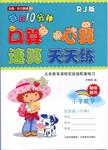题目内容
—Hurry up!There’s a bus coming!
—Why run?There will be_____one in two or three minutes.
A.anotherB.other
C.the otherD.any other
练习册系列答案
 每日10分钟口算心算速算天天练系列答案
每日10分钟口算心算速算天天练系列答案
相关题目
题目内容
—Hurry up!There’s a bus coming!
—Why run?There will be_____one in two or three minutes.
A.anotherB.other
C.the otherD.any other
 每日10分钟口算心算速算天天练系列答案
每日10分钟口算心算速算天天练系列答案